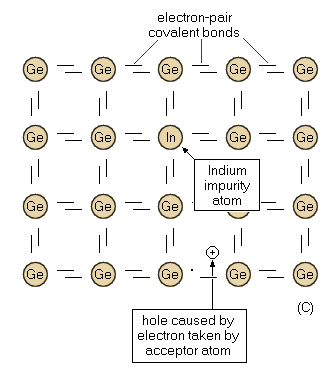| Transistor Basics is a free introductory textbook on transistors and their basic applications. See the editorial for more information.... |

|

Home  Basic Semiconductor Physics Basic Semiconductor Physics  Crystal Structure Crystal Structure  Acceptors - P-Type Germanium Acceptors - P-Type Germanium |
|






|
|
|
Acceptors - P-Type GermaniumAuthor: Leonard Krugman Holes, Figure 1-3 (C) illustrates a second method of forming transistor germanium. In this case an impurity having three valence electrons (indium) is added to the pure germanium crystal. Each such trivalent impurity atom replaces a germanium atom, and in order to complete its covalent bond with neighboring germanium atoms, the impurity atom borrows a fourth electron from any one of the other germanium groups. This destruction of a germanium covalent bond group forms a hole. A hole is an incomplete group of covalent electrons which simulates the properties of an electron with a positive charge. These trivalent-type impurities are called acceptors because they take electrons from the germanium crystal. Germanium containing acceptor impurities is called P-type because conduction is effected by Positive charges.
Fig. 1-3.(C) P-type germanium. Connection of a battery across a P-type crystal causes the holes to move toward the negative terminal. When a hole reaches the negative terminal, an electron is emitted from this battery terminal and cancels the hole. At the same time, an electron from one of the covalent bonds enters the positive terminal, thus forming another hole in the vicinity of the positive terminal. The new hole again moves towards the negative terminal. Thus the battery causes a continuous stream of holes to flow through the crystal. Insofar as the flow of current is concerned, hole flow from the positive to the negative terminal of the crystal has the same effect as electron flow from the negative to the positive terminal.
|
|
Home  Basic Semiconductor Physics Basic Semiconductor Physics  Crystal Structure Crystal Structure  Acceptors - P-Type Germanium Acceptors - P-Type Germanium |
|
Last Update: 2010-11-17


